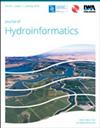Separation of pressure signals caused by waves traveling in opposite directions
IF 2.2
3区 工程技术
Q3 COMPUTER SCIENCE, INTERDISCIPLINARY APPLICATIONS
引用次数: 0
Abstract
Hydraulic transient analysis allows the condition assessment of pipeline systems by the measurement of a system's transient pressure response subject to input pressure excitations. The detection of a pressure wave's arrival time and amplitude at one or more sections can be used to detect unexpected anomalies, such as leaks, blockages, or corroded sections. Wave separation approaches, based on signal processing techniques involving two sensors, enable a directional attribution to any measured pressure perturbations. Being able to determine the direction of origin of a perturbation through a signal-splitting approach greatly facilitates anomaly detection through the resolution of this ambiguity. The signal-splitting procedure can be sensitive to the analysis conditions (i.e. the signal processing procedure used, the presence of noise within the signal, and the spacing of the sensors) and, as a result, produce spurious results. This paper explores this issue and proposes, and analyses, a range of strategies to improve the signal-splitting results. The strategies explored involve the consideration of alternative time and frequency-domain formulations; the use of filters and wavelet to condition the signal; and processing the time-shifted differenced signal as opposed to the original raw signal. Results are presented for a range of numerical and laboratory systems.由反方向波传播引起的压力信号分离
水力瞬态分析允许通过测量系统在输入压力激励下的瞬态压力响应来评估管道系统的状态。检测压力波在一个或多个段的到达时间和振幅,可用于检测意外异常,如泄漏、堵塞或腐蚀段。波分离方法基于涉及两个传感器的信号处理技术,可以对任何测量到的压力扰动进行定向归因。能够通过信号分裂方法确定扰动的起源方向,通过解决这种模糊性极大地促进了异常检测。信号分裂过程可能对分析条件(即所使用的信号处理过程、信号中噪声的存在以及传感器的间距)很敏感,因此会产生杂散结果。本文对这一问题进行了探讨,提出并分析了一系列改进信号分割效果的策略。所探索的策略包括考虑替代的时域和频域公式;利用滤波器和小波对信号进行调理;处理时移差分信号而不是原始信号。结果提出了一系列数值和实验室系统。
本文章由计算机程序翻译,如有差异,请以英文原文为准。
求助全文
约1分钟内获得全文
求助全文
来源期刊

Journal of Hydroinformatics
工程技术-工程:土木
CiteScore
4.80
自引率
3.70%
发文量
59
审稿时长
3 months
期刊介绍:
Journal of Hydroinformatics is a peer-reviewed journal devoted to the application of information technology in the widest sense to problems of the aquatic environment. It promotes Hydroinformatics as a cross-disciplinary field of study, combining technological, human-sociological and more general environmental interests, including an ethical perspective.
 求助内容:
求助内容: 应助结果提醒方式:
应助结果提醒方式:


